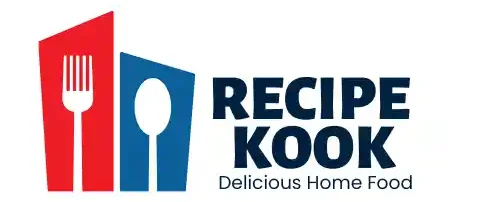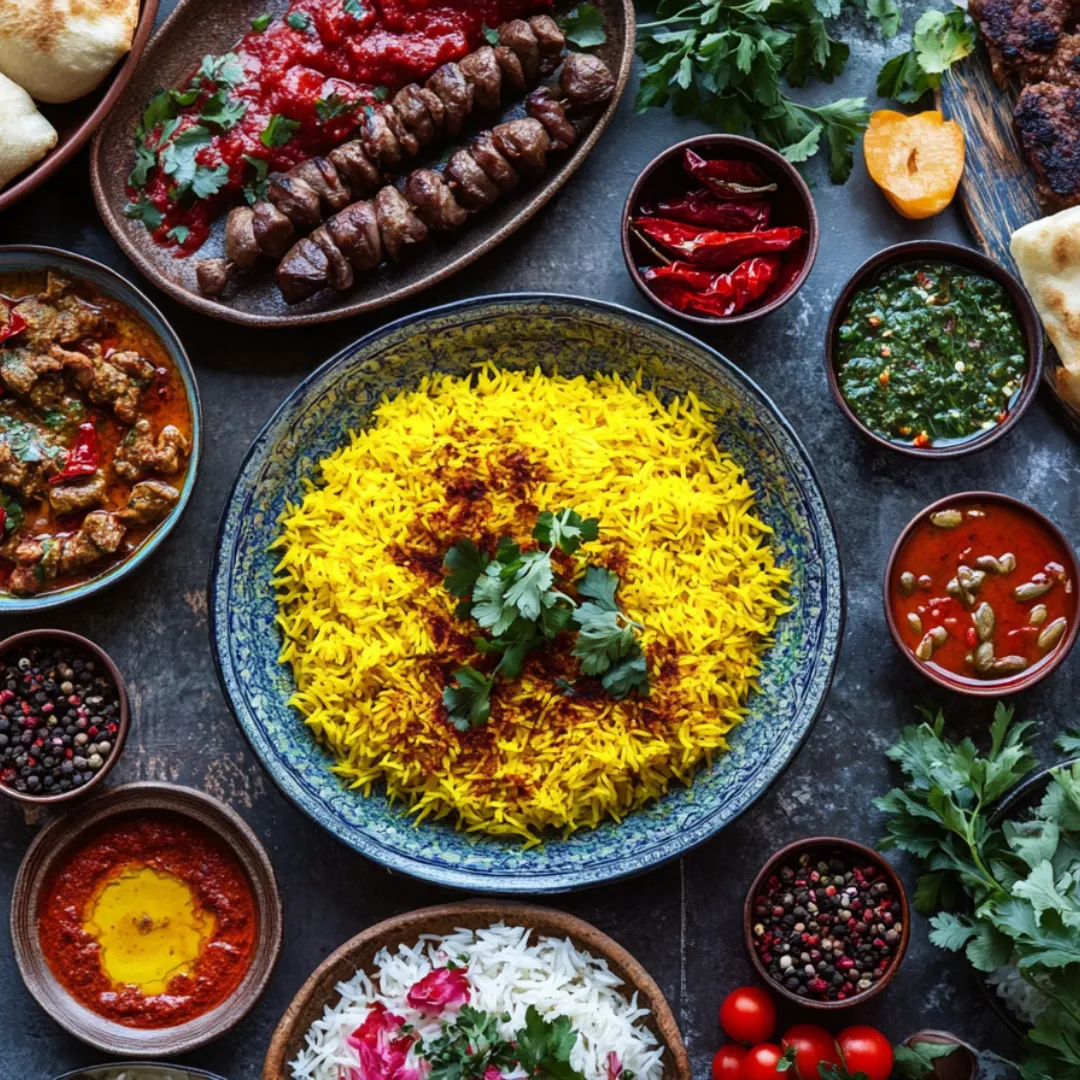Persian cuisine is a rich and diverse culinary tradition that dates back thousands of years. Rooted in history and influenced by trade routes, it blends fragrant spices, fresh herbs, and slow-cooked stews to create dishes that are both nourishing and delicious. From saffron-infused rice to hearty stews and delicate sweets, Iranian recipes offer a perfect balance of flavors that cater to all tastes.
In this article, we’ll explore traditional Iranian recipes, covering everything from main courses and side dishes to desserts and breakfast staples. We’ll also dive into the key ingredients, cooking methods, and cultural significance of Persian food. Whether you’re new to Persian cooking or looking to expand your recipe collection, this guide will introduce you to the best flavors of Iranian cuisine.
Table of Contents
Introduction to Iranian Cuisine
The Rich History of Persian Food
Persian cuisine has a history as vast as the Persian Empire itself. It has been shaped by influences from the Middle East, Central Asia, and even Europe, yet it maintains a distinct identity. Traditional Iranian recipes are known for their use of aromatic spices, dried fruits, and nuts, creating a perfect blend of sweet and savory flavors.
The Silk Road played a crucial role in shaping Persian cuisine, introducing saffron, pomegranates, pistachios, and exotic spices to the region. These ingredients became staples, forming the foundation of many classic Iranian dishes.
Key Ingredients in Iranian Cooking
Authentic Iranian recipes rely on a handful of essential ingredients that define the flavors of Persian cuisine:
- Saffron – The most prized spice, giving dishes a golden hue and distinct aroma.
- Turmeric and cinnamon – Commonly used in stews and rice dishes.
- Pomegranates – Used in sauces, salads, and even stews like Fesenjan.
- Herbs (parsley, cilantro, mint, and dill) – Often used fresh to enhance dishes.
- Dried limes (limoo amani) – Add a tangy depth to Persian stews.
Cooking Techniques and Traditional Methods
Persian cooking is all about slow cooking and layering flavors. The most famous technique is Dum-style cooking, where rice is steamed to achieve the perfect texture. Another hallmark is the use of Tahdig, the crispy golden crust that forms at the bottom of rice pots—a prized delicacy in Iranian cuisine.
Stews, or khoresh, are another cornerstone of Persian cooking. They simmer for hours, allowing the flavors to meld beautifully. Grilling is also a major technique, with Persian kebabs being a staple at gatherings and celebrations.
By mastering these Persian cooking techniques and using authentic ingredients, anyone can bring the magic of Iranian recipes into their kitchen.
Essential Iranian Recipes to Try
Iranian cuisine is packed with aromatic flavors, vibrant colors, and rich textures. From fluffy saffron rice to hearty stews and grilled kebabs, Persian dishes have something for everyone. Below, we explore some must-try Iranian recipes that showcase the heart and soul of Persian cooking.
Persian Rice Dishes: The Heart of Every Meal
Rice is an essential part of Iranian cuisine, often prepared with saffron, barberries, and fragrant herbs. The way it’s cooked and presented is a true art form in Persian culture.
- Tahdig – The Crispy Golden Rice: Tahdig is the holy grail of Persian rice dishes. This crispy, golden layer forms at the bottom of the rice pot and is considered the most coveted part of the meal. It’s often flavored with butter, yogurt, or saffron for an extra crunch.
- Chelo and Polo – Saffron Rice Varieties: Chelo refers to plain, fluffy Persian rice, usually served with kebabs or stews, while Polo is a mixed rice dish infused with ingredients like barberries (zereshk), dill, fava beans, and pistachios. Popular versions include Baghali Polo (dill and fava bean rice) and Zereshk Polo (barberry rice).
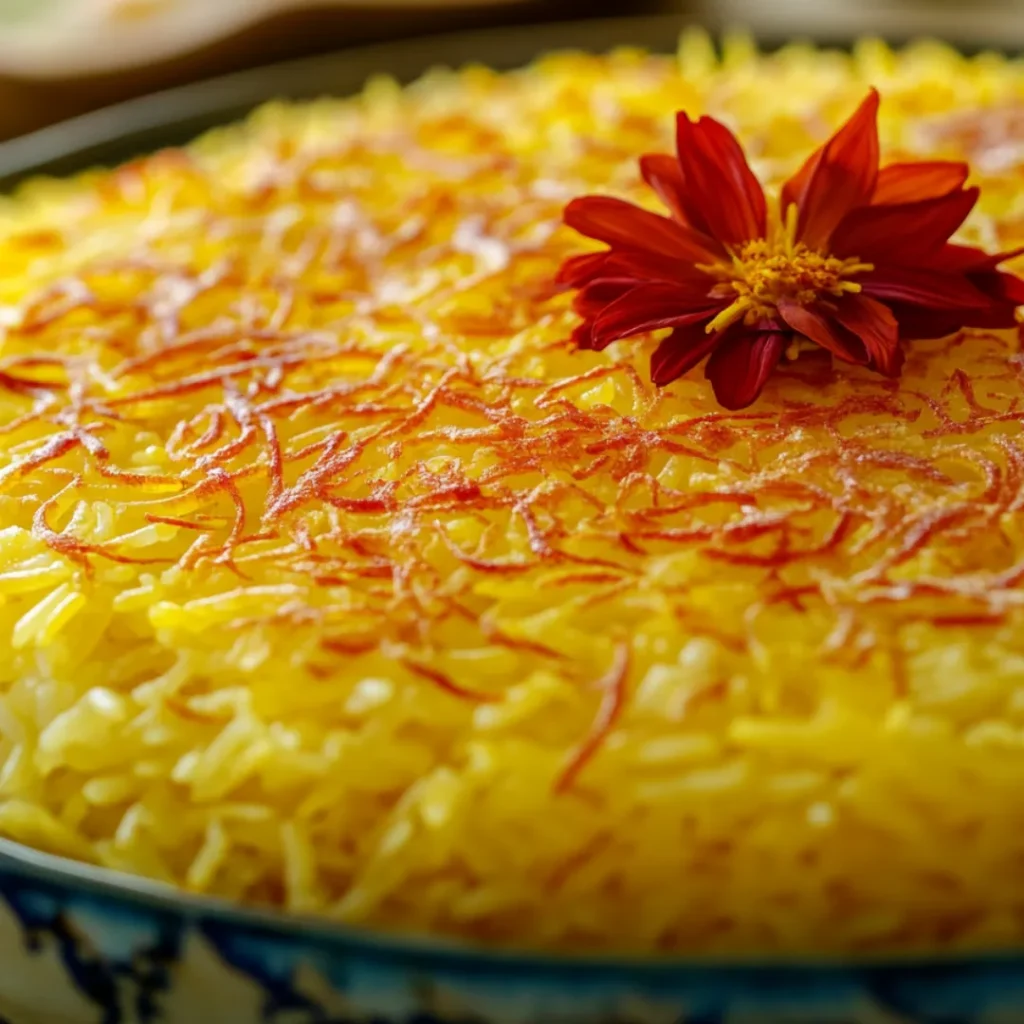
Looking for more rice-based inspirations? Check out these Rice Cooker Recipes for additional meal ideas.
Popular Iranian Stews (Khoresh)
Persian stews, or khoresh, are slow-cooked and deeply flavorful. They are usually paired with rice for a perfectly balanced meal.
- Ghormeh Sabzi – Herb Stew with Lamb and Beans: Known as Iran’s national dish, Ghormeh Sabzi is a flavorful stew made with fresh herbs, dried limes, red kidney beans, and tender lamb. It has a distinct tangy and savory taste that’s truly unique.
- Fesenjan – Pomegranate Walnut Stew: This luxurious stew combines ground walnuts and pomegranate molasses with slow-cooked chicken or duck. The result? A rich, slightly tangy, and nutty dish that’s often served at special occasions.
Kebabs: The Persian Barbecue Tradition
Persian kebabs are famous worldwide, known for their juicy texture and smoky flavors. They are often served with grilled tomatoes, buttered saffron rice, and fresh herbs.
- Kabab Koobideh – Minced Meat Skewers: This classic Persian kebab is made with ground lamb or beef, seasoned with onion, salt, and spices, then grilled over open flames.
- Joojeh Kabab – Saffron Chicken Kebabs: Joojeh Kabab is a marinated chicken kebab, infused with saffron, lemon juice, and yogurt. It’s grilled to perfection and best enjoyed with fresh Persian bread or rice.
Traditional Iranian Appetizers and Side Dishes
No Persian meal is complete without flavorful appetizers and side dishes that add freshness and balance. These small plates enhance the overall dining experience.
Must-Try Persian Starters
- Kashke Bademjan – Creamy Eggplant Dip: This popular Persian appetizer is made with roasted eggplant, whey (kashk), caramelized onions, and garlic. It’s served with Persian flatbread (lavash or sangak) and topped with mint oil and walnuts for extra flavor.
- Mast-o-Khiar – Persian Yogurt and Cucumber Dip: This cooling side dish is similar to Greek tzatziki, combining yogurt, diced cucumbers, dried mint, and sometimes raisins or walnuts. It pairs beautifully with spicy kebabs and stews.
Popular Iranian Salads and Side Dishes
- Shirazi Salad – A Refreshing Tomato-Cucumber Salad: Made with finely chopped tomatoes, cucumbers, and red onions, this salad is dressed with lime juice and dried mint, making it the perfect refreshing side for any Persian meal.
- Torshi – Pickled Vegetables with Persian Spices: Persian cuisine includes a variety of pickled vegetables (torshi), which add a tangy contrast to rich dishes. They are typically made with cauliflower, carrots, garlic, and vinegar.
Want to explore more side dishes? Check out these Healthy Greek Yogurt Recipes for similar creamy delights.
Iranian Breads and Breakfast Staples
A Persian breakfast is a blend of simple, fresh, and comforting flavors. Whether it’s traditional Iranian bread, creamy dairy spreads, or rich stews, breakfast in Iran is an experience in itself. Here are some must-try morning staples from Iranian recipes.
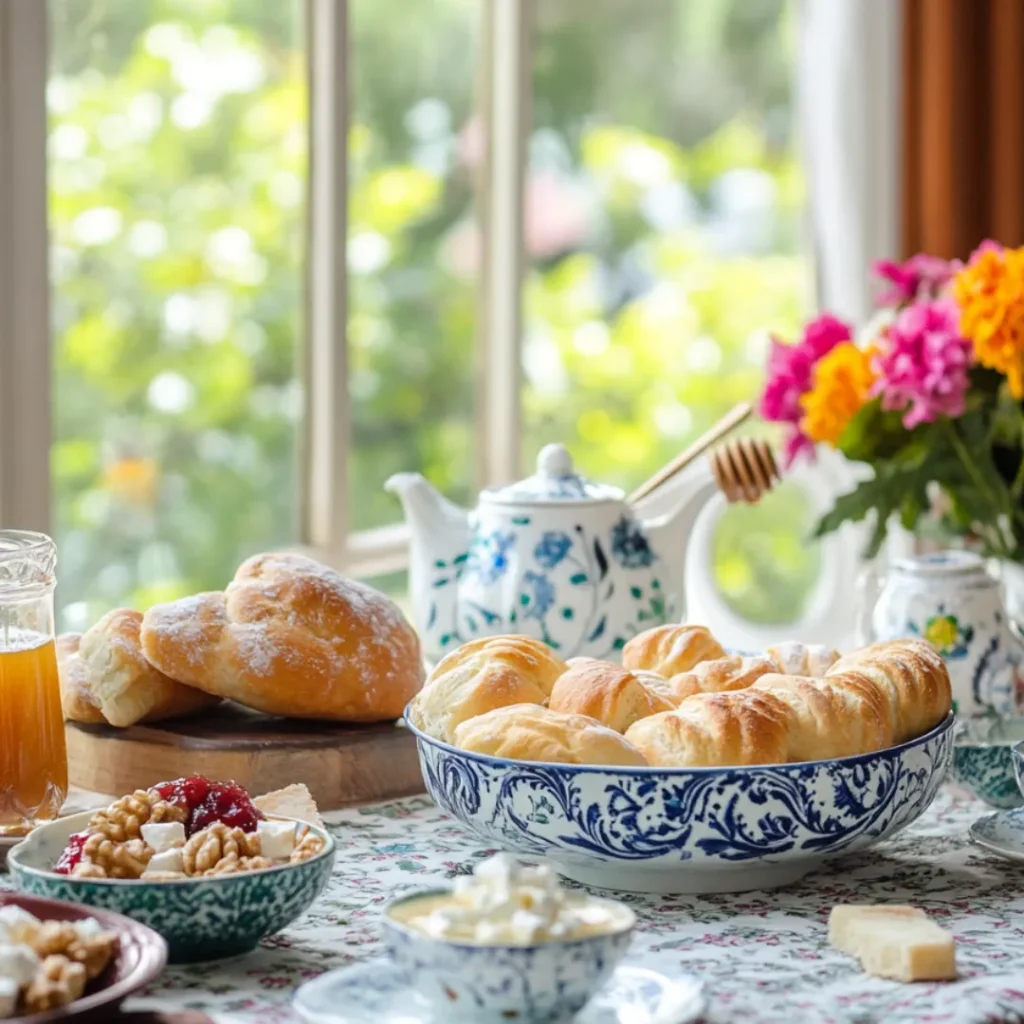
Traditional Persian Breakfasts
- Nan-e Barbari and Sangak – Classic Iranian Breads: Barbari is a thick, chewy bread with a golden crust, often sprinkled with sesame or nigella seeds. It’s a perfect companion to butter, feta cheese, or jams. On the other hand, Sangak is a whole wheat sourdough flatbread, traditionally baked on hot stones, giving it a crispy texture.
- Haleem and Kalleh Pacheh – Traditional Morning Dishes:
- Haleem is a slow-cooked wheat and meat porridge, served warm with butter, cinnamon, and sugar. It’s filling, nutritious, and keeps you full for hours.
- Kalleh Pacheh, a rich, gelatinous stew made from lamb’s head and trotters, is considered a hearty Iranian breakfast. While it may not be for everyone, it’s a beloved dish for early risers in Iran.
Persian Tea Culture and Accompaniments
No Persian breakfast is complete without a steaming cup of chai (Persian tea). Iranian tea is strong, fragrant, and typically served in delicate glasses with sugar cubes or saffron rock candy (nabat).
- How to Make the Perfect Persian Chai: Persian tea is brewed using a samovar (traditional kettle), allowing for a slow infusion of flavors. It’s often enjoyed alongside fresh herbs, cheese, and nuts.
- Persian Sweets That Pair with Tea: Popular choices include dates stuffed with walnuts, nokhodchi (chickpea flour cookies), and saffron-scented pastries.
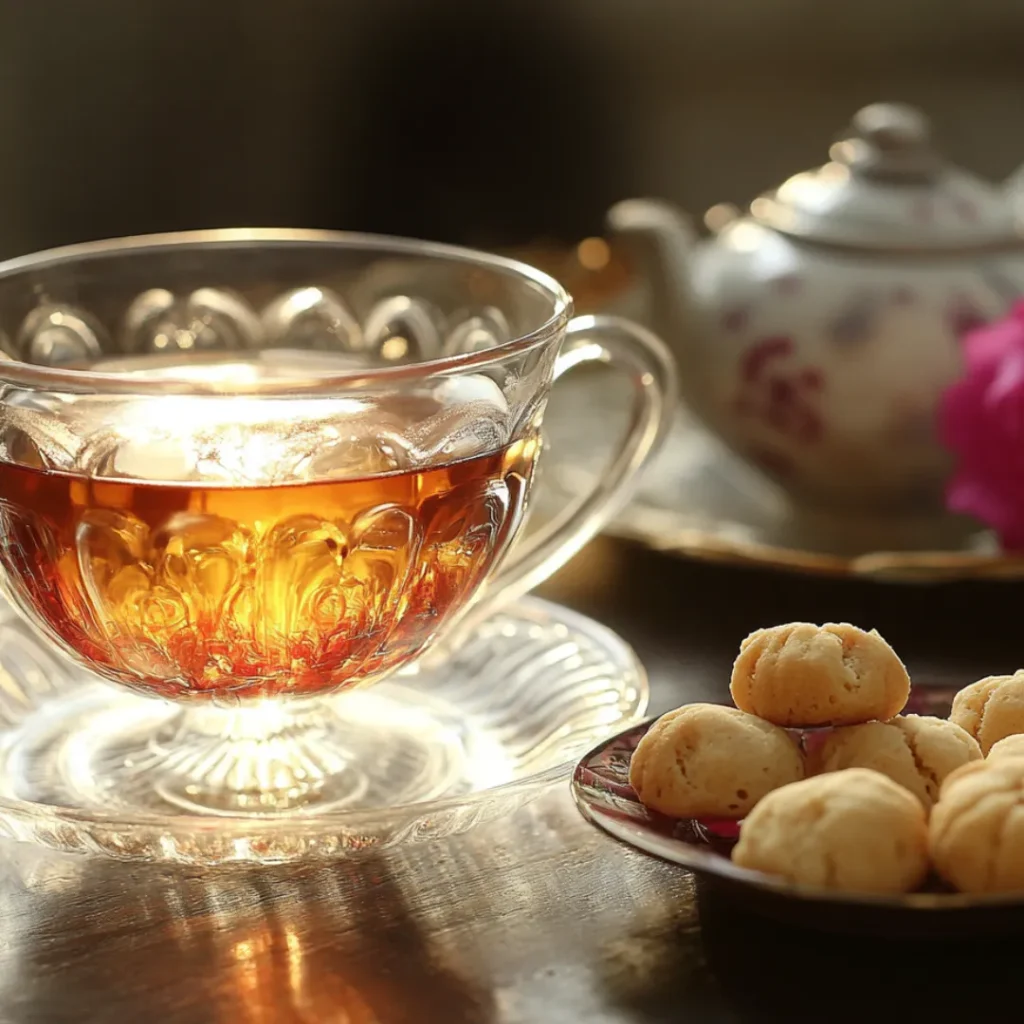
For more traditional bread recipes, explore this Sourdough Bagel Recipe for a different take on homemade bread.
Persian Sweets and Desserts
Iranian desserts are a delightful mix of floral aromas, nutty textures, and syrupy goodness. These sweet treats are often flavored with saffron, rosewater, and cardamom, creating an irresistible balance of richness and fragrance.
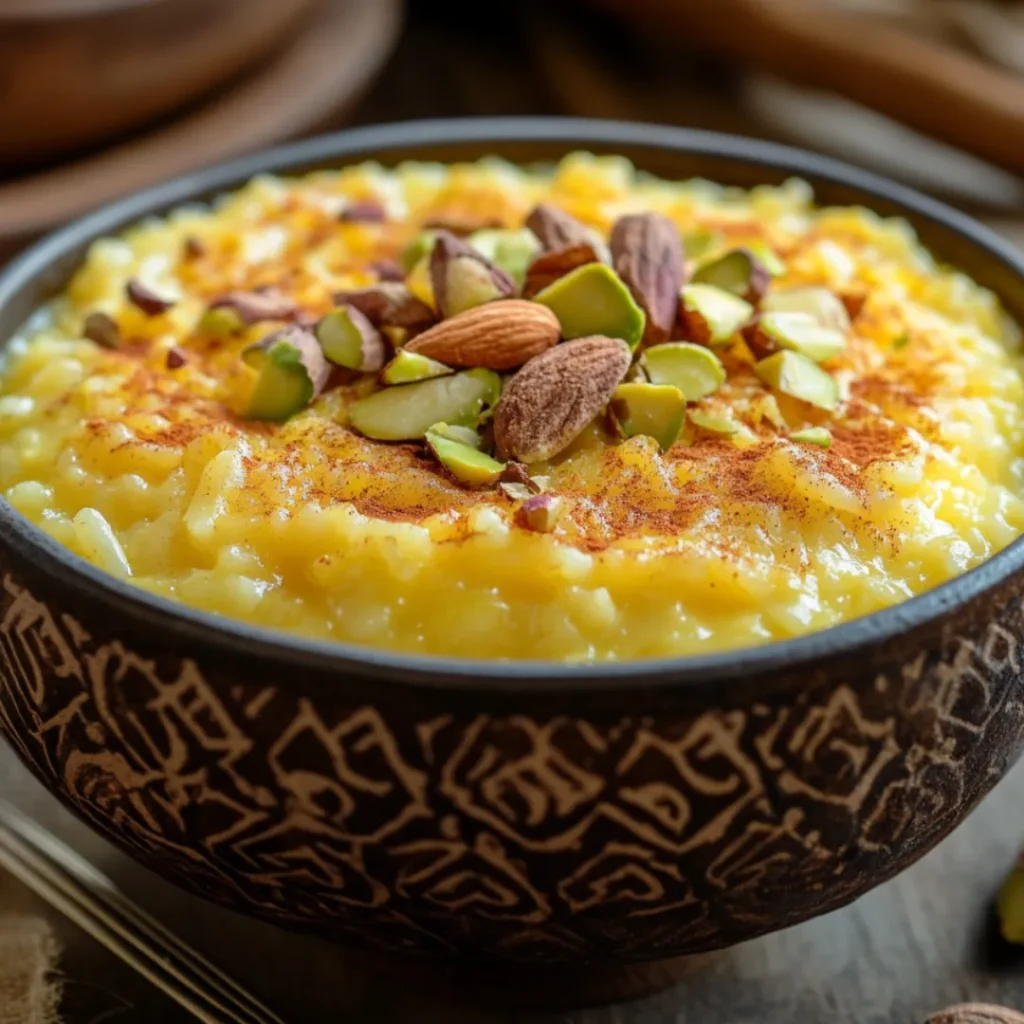
Famous Iranian Desserts
- Baklava – The Iranian Take on a Classic Sweet: Unlike Turkish baklava, Iranian baklava is less syrupy and often infused with rosewater and ground cardamom. The layers of flaky pastry and crushed nuts make it an elegant, indulgent treat.
- Sholeh Zard – Saffron Rice Pudding: This golden-hued Persian dessert is made with rice, saffron, rosewater, and sugar, then garnished with cinnamon and slivered almonds. It’s a light yet aromatic dessert perfect for special occasions.
Persian Ice Cream and Refreshments
- Bastani Sonnati – Saffron and Rosewater Ice Cream: This traditional Iranian ice cream is made with saffron, rosewater, pistachios, and frozen chunks of cream, giving it a creamy yet floral taste. It’s often served sandwiched between wafers for an extra crunch.
- Faloodeh – Persian Frozen Noodle Dessert: This unique, semi-frozen treat consists of vermicelli-like rice noodles soaked in a sweet, rosewater-infused syrup. It’s often served with lime juice and sour cherry syrup, creating a refreshing contrast of flavors.
Want to try more dessert recipes? Check out these Easy Dessert Recipes for quick and delicious sweet treats.
How to Cook Iranian Recipes at Home
Cooking Iranian recipes at home may seem daunting, but with the right ingredients and techniques, anyone can master Persian flavors. Whether you’re a beginner or an experienced cook, these tips will help you bring authentic Persian cuisine to your table.
Tips for Finding Authentic Ingredients
To cook traditional Iranian recipes, you’ll need a few essential ingredients that define Persian flavors:
- Saffron – Look for high-quality Persian saffron, known for its deep red threads and strong aroma.
- Dried limes (Limoo Amani) – These add a tangy, slightly bitter taste to stews like Ghormeh Sabzi.
- Rosewater and Orange Blossom Water – Used in Persian sweets and desserts.
- Persian Rice (Tarom or Sadri) – These rice varieties are ideal for achieving fluffy, aromatic rice dishes.
Most of these can be found in Middle Eastern grocery stores or ordered online.
Essential Persian Cooking Tools
Having the right tools makes Persian cooking easier and more authentic:
- Nonstick Pot for Tahdig – This helps create the perfect crispy golden rice crust.
- Samovar or Teapot – Essential for brewing Persian tea.
- Mortar and Pestle – Useful for grinding saffron into powder before steeping.
Beginner-Friendly Persian Recipes
If you’re new to Iranian recipes, start with:
- Zereshk Polo (Barberry Rice) – A simple yet flavorful rice dish.
- Mast-o-Khiar (Yogurt and Cucumber Dip) – A quick, refreshing side.
- Joojeh Kabab (Saffron Chicken Skewers) – Easy to grill and packed with flavor.
Frequently Asked Questions
What is Iran’s most popular food?
One of the most famous Iranian recipes is Ghormeh Sabzi, a herb and lamb stew with dried limes and kidney beans. It’s known as Iran’s national dish and is a staple at Persian family gatherings. Another favorite is Chelo Kabab, which pairs grilled kebabs with saffron rice and butter.
What is a traditional Iranian dish?
Traditional Persian dishes include stews, rice dishes, and kebabs. Some of the most well-known are:
- Fesenjan – A rich, tangy stew made with pomegranate and walnuts.
- Baghali Polo – Saffron rice with dill and fava beans, often served with lamb.
- Ash Reshteh – A hearty noodle and herb soup, commonly eaten during Nowruz (Persian New Year).
Is a Persian diet healthy?
Yes! Iranian recipes often use fresh herbs, legumes, and lean meats, making them nutritious and balanced. Persian food incorporates anti-inflammatory spices like turmeric and saffron, while dishes like Shirazi Salad and Mast-o-Khiar provide refreshing, probiotic-rich options.
What is a typical Iranian breakfast?
A classic Iranian breakfast includes flatbreads (Barbari or Sangak), feta cheese, walnuts, and honey. For a heartier meal, some Iranians enjoy Haleem (wheat and meat porridge) or Kalleh Pacheh (lamb head and feet stew), paired with hot Persian tea.
